1 Audio Spectrum Analyzer ("Spectrum Lab")
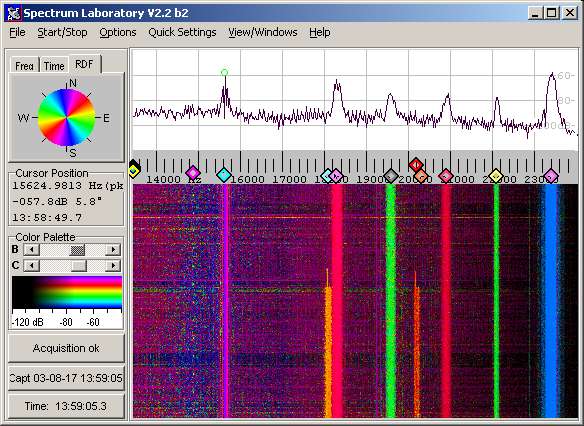 This program started as a simple FFT program running under DOS a long time ago, but it is now a specialized audio analyzer, filter, frequency converter, hum filter, data logger etc
This program started as a simple FFT program running under DOS a long time ago, but it is now a specialized audio analyzer, filter, frequency converter, hum filter, data logger etc
[ updated 2024-08-27 ]
A collection of PC Sound Card Software
The software for older OS (Operating Systems) and hardware (your computer) are disappearing fast as technology marches forward. What we have here is a small resource of information culled from the Internet and social interactions.
Comments might be from other peoples' opinions and not necessarily my own.
The software on this page are mostly freeware and can be downloaded freely from the internet. Software for purchase will be shown with $<10 $$<100 $$$<1000.
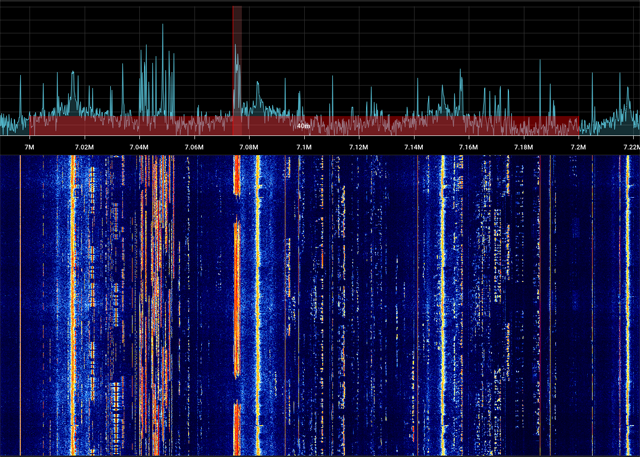
Figure #75
 This program started as a simple FFT program running under DOS a long time ago, but it is now a specialized audio analyzer, filter, frequency converter, hum filter, data logger etc
This program started as a simple FFT program running under DOS a long time ago, but it is now a specialized audio analyzer, filter, frequency converter, hum filter, data logger etc
[ updated 2024-08-27 ]
Real time DSP filter particularly for applications of amateur radios IIR, FIR filter, low-pass, high-pass, band-pass filter, band suppressor (notch filter) individually adjustable noise filter, irregular signal filter, hum filter, peak filter frequency tuning and inverting mixer support support of several soundcards (also virtual soundcards) e.g VAC Virtual Audio Cable small file size simple to use multiple language support
By JE3HHT - Makoto Mori DSP filter with Windows and Soundcard Win95/98/ME/NT/2000/XP/Vista & Win7 (Seems to run on Windows 10 & 11, but vendor has not tested.)
The RoMac 10 Band Equalizer 2012 coupled with your present computer's soundcard, affords you the finest Windows based digital equalizer made for the Amateur Radio community. Using professional techniques such as audio equalization will enhance the audio quality of your signal. The RoMac 10 Band Equalizer 2012 is like having a full featured audio studio in one package.
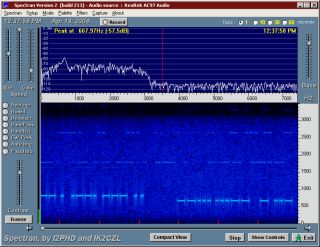 Spectran is a program to do real time or deferred spectral analysis / waterfall display, in addition to real time audio filtering (band pass, denoising, band reject and CW peaking) of audio signals, using the PC sound card to digitize the input analog signal, or taking as input a WAV file. Its characteristics are well suited to dig weak signals buried into noise, thanks to a selectable bin size down to 21 millihertz. On the opposite site, it can visualize normal CW signals, resolving individual dots and dashes (with a reasonably fast PC).
Spectran is a program to do real time or deferred spectral analysis / waterfall display, in addition to real time audio filtering (band pass, denoising, band reject and CW peaking) of audio signals, using the PC sound card to digitize the input analog signal, or taking as input a WAV file. Its characteristics are well suited to dig weak signals buried into noise, thanks to a selectable bin size down to 21 millihertz. On the opposite site, it can visualize normal CW signals, resolving individual dots and dashes (with a reasonably fast PC).
 Voice Shaper is a speech pre-processor for SSB transceivers. It receives the voice signal from the microphone connected to the soundcard, and sends the processed audio back to the soundcard in real time. The following processing functions are implemented in the program:
Voice Shaper is a speech pre-processor for SSB transceivers. It receives the voice signal from the microphone connected to the soundcard, and sends the processed audio back to the soundcard in real time. The following processing functions are implemented in the program:
[ updated 2024-08-27 ]
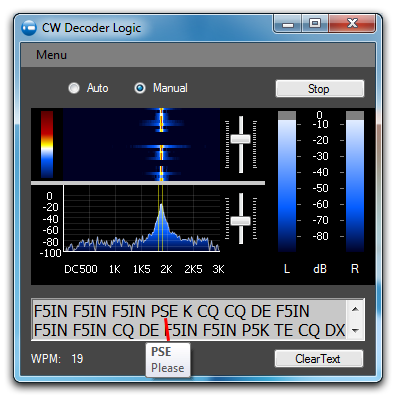 LY3H CW Decoder Logic. A very capable Morse decoder.
Speed 5 to 60 WPM with auto tracking of the CW signal in 3 KHz range or manually select the station.
Auto speed detection in few msecs.
Free software.
LY3H CW Decoder Logic. A very capable Morse decoder.
Speed 5 to 60 WPM with auto tracking of the CW signal in 3 KHz range or manually select the station.
Auto speed detection in few msecs.
Free software.
[ updated 2024-08-27 ]
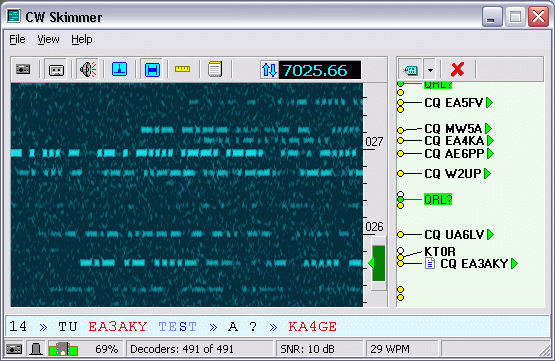 Multi-channel CW decoder and analyzer for Windows
Multi-channel CW decoder and analyzer for Windows
[ updated 2024-08-27 ]
A program to decode morse code (CW) via sound card to text. It can work as narrow-band sound DSP-filter also. No additional hardware required - you need only receiver and computer with a sound card. Can integrate with AALog logger. It is a software morse decoder that really work!
Welcome to the CWTY program. This software is designed to allow CW operators to see coded signals as text CW from their receivers and to transmit CW using the serial port or sound card of the computer. This is accomplished by routing the audio from the receiver audio output to the audio (MIC or Line In) input of the sound port of the computer. The software runs on Windows 10, Windows 8.1/8.0, Windows 7, and Windows Vista operating systems. The program is optimized for keyboard to keyboard operation.
The terminal program for CW-operators. You can transmit both from the keyboard and from a paddle connected to game or LPT ports. You can also operate in paddle iambic mode. Control of the transceiver (PTT and CW keying) is made through one of the COM or LPT ports. CwType can integrate with AALog software.
When I returned to Amateur Radio my CW was decidedly rusty. What I felt I needed was a CW Trainer to get my speed back. I looked around the Web and found an article by Dave Finley N1IRZ on a method of CW training developed by a German psychologist called Ludwig Koch back in the 1930's. Reading though Dave's article, I decided that it all made a lot of sense. Basically you start off learning the code at the speed you would like to achieve. Unlike the Farnsworth method which seeks to reduce the gap between the letters as you become more efficient, Koch came up with the idea that you should start off just learning two letters at full speed and add an additional letter once you reach 90% proficiency until you have mastered them all. Since you are only learning one new letter or figure at a time, your frustration is significantly reduced. Dave Finley gave a suggested order for learning the letters and figures and recommended a programme called Super Morse to use as a trainer. I quickly realised that Super Morse offered more features than were required to learn Morse by the Koch method and decided to write my own programme orientated towards the Koch method.
Contest simulator for Windows
MRP40 is a powerful and highly-effective ham radio software program that decodes received CW audio that has been fed to a computer's sound card. The decoded text is displayed on the computer's monitor. For transmitting CW, the program encodes keystrokes from the computer's keyboard. Hams use MRP40 to send and read QRQ (high-speed) CW, to help read weak DX signals, and to improve CW contest scores.... With MRP40 you are number one on the air! ...
RoMac Software's Automatic CW identifier and Tuning Pulser utilizes your present computer's sound card to automatically send your callsign at preset intervals, to insure your stations compliance with FCC regulations. Also incorporated is a Tuning Pulser aka Pecker, to aid in reducing stress and heat while tuning your amplifier, antenna tuner, etc.
ACARSD is an ACARS decoder which attempts to decode ACARS transmissions in real-time using up to four Soundcards. ACARSD is also a realtime ACARS Server / ACARS webserver, for the worldwide spotter and ACARS community, if you wish.
This program does all the traffic between the packet applications (AGWFWD, AGWTERMINAL, AGWCLUSTER and others) and your TNCs. It runs as an Icon. It has the capability to handle 100 tncs and 100 applications at the same time. For the moment works with external tncs in KISS mode, Baycom Like serial modems for 1200-9600, DRSI cards (4 sharing the same IRQ line 8 Radioports), Baycom USCC cards, Sound Cards with the PSA chipset 1200/9600, OE5DXL,YAM, OptoScc, PetScc . New drivers for new hardware will be available as soon as I get the Hardware!!! It handles also the special dual port tncs of Kantronics (KAM,KPC96 etc.) and AEA (PK900 etc). This program has the capabilities to handle different applications it does that only if each application has a different call. Eg agwfwd.exe with SV2AGW-1,Agwterminal.exe SV2AGW, agwcluster.exe SV2AGW-3 etc. That way with just a tnc you work like you have two or three or four different tnc and TRCVRs. In case you have more than a tnc then each program can work all the tncs at the same time. You can eg. Chat with a friend with the agwterminal.exe in tnc1 (e.g.. vhf 1200bauds) and also receive a YAPP form tnc2 (eg. UHF 9600bauds). And also receive your mail from tnc1 and cluster dxspots also from tnc1. The combinations are unlimited. What the program doesn't do is that of gateway for other stations. Other stations cannot gateway from your tncs. Also it doesn't serves as a digi . This is done for two reasons. First I don't like the idea "every tnc and a digi". Leave it for clubs and special packet teams to decide if we need a digi or not. Second because I have to write a lot of code and I can't do it right now. Maybe in the future if I receive many requests for those operations. AGW Packet Engine can also use the native build in TCPIP protocol over Packet Radio.
This program needs no other explanations because it is just a terminal program. The only difference is that it is multitasking. This means that you can have multiple connects and you can YAPP without restrictions. You can receive as many YAPPs as you wish simultaneously. If you have more than a RadioPort (You have more than a TNC) you can connect in any RadioPort. You can have also unlimited number of connections (about 100). Script Files. You can run at any time a script file with packet commands. Remote Control. Any station that connects you can remote the program if it has the remote Privilege. It can dir and receive a file from your disks etc. The AGWterminal has not a Help file. This isn't so big problem. You ask me about the remote control. Just enter from the properties menu and the remote dialog the callsigns. Each time someone wishes to remote receive files from you will type the "REMOTE" command. If its call is in the list he will get remote access otherwise not. Everyone can send you a Yapp file. The program will receive the file. You don't have to do anything to receive a Yapp file. Just watch. You can also specify a file to send when someone connects you. Fill the proper dialog from the properties page. In this file write the follow ,if you wish. "Type REMOTE for remote control". Then add anything else you wish. The file must be a valid text file (no word-processing file). The program is much faster in sending from other dos applications. You will see it if you work 9600b packet station. You have the ability to use the program also as a telnet client for TCPIP connections.
AGWUIDigi is a program that help you setup your packet station to act as an APRS Digipeater. Its unique feature is that it is written to take advantage of the Windows XP facilities. Among others can act as Cross Port APRS digi if you have more than a RadioPort. Now Can be used also as Internet Gateway to feed data to and from Internet. The program is the Perfect Companion to AGWTracker.
Modern APRS terminal. Advanced tracking/messaging facilities with online map displays.
Airlink Express Box Airlink Express is a user friendly digital mode software package for the Amateur Radio Operator. The software is compatible with Microsoft Windows XP, Microsoft Windows Vista, and Microsoft Windows 7. (Seems to run on Windows 10 & 11, but vendor has not tested.) It offers PSK, MFSK and RTTY digital modes with logging and macro capabilities. If you have ever used the Digipan software you will be immediately familiar with Airlink Express. With the release of Windows Vista and Windows 7, Microsoft introduced a new sound architecture. Airlink Express is developed to support this new sound architecture, yet it maintains complete backward compatibility with Windows XP. Airlink Express brings back the familiar volume slider interface you've become used to from older Windows versions.
Ao40Rcv is a Windows program that can be used to monitor radio satellite telemetry signals using a soundcard as the source.
APRSISCE/32 is an advanced Automatic Packet Reporting System (APRS) Client for Amateur Radio, written for Windows and Windows Mobile (CE). It will also run on Linux and Mac OS under WINE, as well as other virtual machines. APRSISCE/32 can be configured to run connected directly to the APRS-IS via an internet connection, as well as connected to the APRS-RF network via AGWPE, a TNC, or one of the APRS capable Radios including the Kenwood TH-D72/TM-D710 and Yaesu FTM-350.
Beacon- Time Wizard - or "BTW" - provides a unique collection of informational views and tools - for ham radio operators and SWL listeners - to boost your HF radio pleasure and augment the effectiveness of the NCDXF/IARU International Beacon Network.
BPQ for DOS and BPQ32 for Windows were written by John Wiseman G8BPQ/GM8BPQ and have a considerable following of appreciative users. BPQ32 includes BPQMailChat, a modern BBS and Chat system. BPQ32 offers three program interfaces. The DLL interface is the fundamental and most capable interface and is recommended for new applications. An AGW-like front end interface is offered permitting BPQ32 to be used with any program currently supporting AGWPE. The third, now deprecated, interface method is ActiveX. An AGW back end interface has been added to allow BPQ32 to use sound card modems. Many useful BPQ32 utilities and configuration examples are included.
Chip64 is the software that implements CHIP64 and CHIP128 spread spectrum modes.
The ChromaPIX concept is to develop a high-performance SSTV workstation system, that exploits the newest DSP, imaging, and operating-system technologies. Although the program is not "feature-crippled" or date-limited, unregistered copies are time-limited to 30 minutes of operation per session.
DigiPan stands for "Digital Panoramic Tuning" and brings the ease and simplicity of PANORAMIC reception and transmission to PSK31and PSK63 operation. DigiPan provides a panoramic display of the frequency spectrum in the form of an active dial scale extending the full width of the computer screen. Depending upon the transceiver IF bandwidth, it is possible to "see" as many as 40 to 50 PSK31 stations at one time.
Digiplex is a multi-purpose routing engine aimed to work with the AGW Packet Engine by SV2AGW. Some of it's features are: A cross-band AX.25 L2 Smart Digipeater (SMART). A NETROM router (ROUTE). An APRS enabled digipeater (APRS). A high performance router with hop-to-hop ack (DIGIPLEX). It's intended to interoperate with other network infrastructure components such as NETROM nodes and digipeaters present on your LAN but based on other platforms. Also it features other functions such as Telnet remote access, a build-in Web server, the capability to define "managed applications" to be accessed thru it and more... The program is in the process to be developed with upgrades being continually released as part of the beta process.
Digital SSTV software for sound card.
Dire Wolf is a software "soundcard" modem/TNC and APRS * encoder/decoder. It can be used stand-alone to observe APRS traffic, as a digipeater, APRStt gateway, or Internet Gateway (IGate). It can also be used as a virtual TNC for other applications such as APRSIS32, UI-View32, Xastir, APRS-TW, YAAC, UISS, Linux AX25, SARTrack, RMS Express, and many others. Notes: This is a development snapshot that has not gone through the same amount of testing as a normal release. New features may be incomplete. Documentation may be lagging behind new functionality. The Windows binary distribution is in the direwolf-1.7.0- *.zip files below. The Windows version is built for both 32 and 64 bit operating systems. Use the 64 bit version if possible; it runs considerably faster.
This is a computer program for Amateur Radio transmission and reception using a computer and HF radio transceiver. The program provides computer chat-mode operation on the HF bands, using a sound card technique to generate and modulate for transmission using tones at audio frequency, and receive and decode the incoming signals, also at audio frequency. An SSB transceiver translates these signals to and from the HF Amateur Bands. The DominoEX mode is a development from earlier experimental DominoF and DominoG programs, but is not compatible with them. This version (DominoEXFEC V2.0) is compatible with earlier ZL2AFP DominoEX versions, and also with MULTIPSK, with and without FEC. DominoEX operates using a variation of the MFSK technique (MFSK = Multiple Frequency Shift Keying), since MFSK offers very good immunity to interference and ionospheric effects, and is also very sensitive. However, MFSK can be quite difficult to tune in, and suffers from some interference effects, which are usually masked by using error correction. This unique program addresses these limitations in a special way that wipes away all problems. DominoEX is easy to use, and hence ideal for beginners. You will be impressed with the performance!
DSCdecoder allows you to use your PC and soundcard to decode maritime mobile service messages using the Digital Selective Calling (DSC) system and also DGPS and Navtex broadcasts. DSC signalling is used in the MF, HF and VHF bands for distress and calling between ships and coast stations. Navtex messages are broadcast by coast stations and carry infomration about navigational warnings and weather forecasts. Messages that can be decoded include routine calls for test purposes between ships and coast stations; calls to establish communication by some other means (voice, etc.) between a ship and a coast station; notification of routine and safety messages from coast stations; Vessel Traffic Service (VTS) messages, distress messages and distress relay messages. DSCdecoder will decode these messages and display and log their content.
EasyDRF is a Windows application program for sending files over radio using HamDRM format. It has been created primarily to support shortwave broadcast use of HamDRM. HamDRM format was adapted from Digital Radio Mondiale to Amateur Radio use by Cesco, HB9TLK. EasyDRF is an update to the WinDRM application also by HB9TLK. WinDRM was based on the modified Dream DRM encoder/decoder software. EasyDRF now also runs under Wine in Linux EasyDRF is a portable (self-contained) application. It does not need an installer, and makes no changes to the Windows Registry.
I don't intend to waffle on about Easypal... what I do want to say is that it is currently the "Bee's Knees" of Digital SSTV (Slow Scan TeleVision) programs for the PC ! Easypal is being updated all the time... it is currently still in BETA Stage but well worth trying it out. More features are being added... Efficiency Improved.. and users taking up this facet of the Hobby are increasing daily. You will need an interface to connect your PC Soundcard and Transceiver.
Automatic NCDXF beacon monitor for Radio Amateurs, SWL'ers and HF communication engineers.
FDMDV is the latest digital voice mode on HF - it caters to high quality digital voice under poor band conditions, in only 1100Hz bandwidth!.
FLdigi is a complete digital multi-mode program with many advanced features including rig control. Works on Windows XP through Windows 11.
FreeDV is a GUI application for Windows, Linux and MacOS (BSD and Android in development) that allows any SSB radio to be used for low bit rate digital voice. Speech is compressed down to 700-1600 bit/s then modulated onto a 1.25 kHz wide signal comprised of 16 QPSK carriers which is sent to the Mic input of a SSB radio. The signal is received by an SSB radio, then demodulated and decoded by FreeDV. FreeDV 700(B) rivals SSB in it's low SNR performance. At high SNRs FreeDV 1600 sounds like FM, with no annoying analog HF radio noise. FreeDV was built by an international team of Radio Amateurs working together on coding, design, user interface and testing. FreeDV is open source software, released under the GNU Public License version 2.1. The FDMDV modem and Codec 2 Speech codec used in FreeDV are also open source.
NAVTEX decoder is an imaginitively named NAVTEX software decoder for NAVTEX transmissions. All you need is a shortwave radio and a computer to begin decoding signals yourself. I currently have the program running continuously and uploading NAVTEX messages to an online database. The data is also available via WAP at wap.frisnit.com so you can view the messages from your boat on your mobile. From version 2.1.0 you can set up your own local NAVTEX service. This version will automatically upload your messages for viewing online. Apply here for an account on the online database and set up your own NAVTEX receiving station today!
FSQ is a Fast Simple QSO mode designed specifically for HF. It works well under NVIS and sunrise/sunset conditions on the lower bands, and also works well for short skip and grey-line on higher bands. It can also be used on VHF FM, and clearly has a much wider useful range of operating conditions that other more conventional digital modes. FSQ transmission is also well within the capability of micro-controller based devices for low-power propagation transmissions (MEPT and telemetry). The FSQ modulation, coding and FSQCall protocol are publicly disclosed and described, and the software is open source. FSQ was developed by Con Wassilieff ZL2AFP with the assistance of Murray Greenman ZL1BPU. The first QSO took place between these two on 28th November 2014, and the first Alpha executable release was on 17th December 2014. The source code was released with the Beta version 0.23 on 3rd March 2015. The first US version release (V0.24 RC1 by Bob NW8L) was on 29th March 2015. The first full-package public release was by Bob NW8L on 29 April 2015. A version of fldigi with full FSQ support was released by Dave W1HKJ on 16 July 2015, and includes support for Linux and Mac platforms. FSQ is intended for fixed frequency (channelized) operation, with dedicated calling frequencies. It isn't intended as a 'tune around to see what you can find' mode!
Slowfeld - An Experimental Slow Speed Hellschreiber Program by G3PPT
GRITTY is an RTTY decoding program based on the technology developed for the RTTY Skimmer Server project. This is not a skimmer, it decodes a single signal in the 3-kHz audio coming from the transceiver via a soundcard, just like any other RTTY program.
HamScope is a multi-mode communications interface for amateur radio that supports: PSK31 (BPSK and QPSK, see PSK31 Home Page ) RTTY (HamScope uses Makoto Mori's MMTTY Engine) ASCII (both 7 bit and 8 bit protocols using MMTTY) MFSK16 (see MFSK16 Home Page ) PACKET (HamScope uses George Rossopoulos' AGWPE Engine) CW
A program intended for short text messages exchanging over HF radio using IFSK modulation (Incremental Frequency Shift Keying). No additional hardware is required. You only need a transceiver and computer with a sound card. A simple circuit for PTT-control can be used.
For many years Hell-writing (which is a type of simple facsimile developed in 1927) has been considered to be no more than an oddity by the Amateur community, in fact most hams have never heard of Hellschreiber. It was however a simple mode, that offered very good performance in noisy conditions without requiring much power, if only you could find the equipment! Now however, with Digital Signal Processing techniques and very good Windows software, the Amateur Radio fraternity is offered the opportunity to experience an advanced digital mode that requires no apologies for its performance. Hellschreiber can outperform other modes for DX, and requires nothing more than a CW or SSB rig and a PC with a sound card. If you operate PSK31, you can also operate Hell, and what is more, make contacts that are not always possible with PSK31 due to poor conditions. Operation is simple, slick, easy to tune, and ideal for QSOs and nets. Because of the unique nature of Hellschreiber, you actually see an actual replica of the transmitted signal, so the font used, bold or italic, is faithfully reproduced. Noise adds fuzziness to the received text, but cannot cause incorrect characters to print.
MT63 is a digital radio modulation mode for transmission in high-noise situations developed by Pawel Jalocha SP9VRC. MT63 is designed for keyboard-to-keyboard conversation modes, on HF HAM bands.
Stream is a software that implements MFSK16 and MFSK8 modes designed by me and Murray Greenman ZL1BPU. It also offers a series of experimental modes based on FEC, interleaving and several modulation techniques (PSK, QPSK, MSK).
Jason is a weaksignal communication program, especially tailored for LF work.
The multi-purpose FAX, RTTY / SYNOP / NAVTEX and SSTV program for Windows 95, 98, 2000, NT 4.0, XP, Vista and Windows 7 (Seems to run on Windows 10 & 11, but vendor has not tested.)
Experimental program to transfer digital images and texts by JJ0OBZ.
MF TeleType is a Soundcard based audio data Modem which does encode / decode TeleType signals based on the well known and very reliable DTMF (dual-tone, multi-frequency) system.
MixW4 is a new multi-mode, multi-platform software for radio amateurs. A completely new outlook. Tons of new features. JT65 and FT8 modes. KiwiSDR as an external RX. More coming. Now for Windows 7 and newer operating systems.
MMSSTV By JE3HHT - Makoto Mori Slow Scan TV with Windows and Soundcard. For WinXP - Vista - Win7 (Seems to run on Windows 10 & 11, but vendor has not tested.)
RTTY with Windows and Soundcard WinXP - Vista - Win7 (Seems to run on Windows 10 & 11, but vendor has not tested.)
MIL-STD Data Modem Terminal.
Mscan Meteo is a powerful but easy-to-use program for receiving weather facsimile images with your PC and HF radio. Just connect your radio to your computer's sound card or to a SCS PTC II modem. Load the Mscan Meteo software, and you're ready to receive weather fax images, NAVTEX, RTTY, and GRIB files. No dedicated serial port connection is required.
The Swiss-Army-Knife of multi-mode software! Phase Shift Keying modes: BPSK: BPSK31-63-125-250 / CHIP (64/128) / PSK10 / PSKFEC31 / PSKAM10-31-50 BPSK with SSTV: PSK63 F - PSK220F + DIGISSTV "Run" QPSK: QPSK31-63-125-250 8PSK: VDL2 MPSK: MT63 PACKET BPSK1200-250-63-31 + APRS+ DIGISSTV "Run" MIL-STD-188-110A - 4285 HFDL EPIRB-ELT-PLB beacons ARGOS (beacons/satellites) AUTEX On-Off Keying Modes: CW / CCW-OOK / CCW-FSK / QRSS Amplitude modulation mode: APT faxes (NOAA satellites) Frequency Shift Keying modes: PACKET: 110-300-1200 bauds + APRS+ DIGISSTV "Run" PACTOR 1 / AMTOR FEC-Navtex / AMTOR ARQ / SITOR A ASCII / RTTY 45-50-75-100-110-150-200 / SYNOP + SHIP / IEC 870-5 1382 / BIIS / GMDSS DSC / ACARS (VHF) / DGPS / NWR SAME / ARQ-E / ARQ-E3 Multi Frequency Shift Keying modes: MFSK8 / MFSK16/32/64 (+SSTV) OLIVIA / Contestia / RTTYM / VOICE THROB/THROBX DominoF / DominoEX / THOR PAX / PAX2 Automatic Link Establishment (see http://www.hflink.com) MIL-STD-188-141A+ ARQ FAE / ALE400 + ARQ FAE DTMF, SELCAL JT65 (A B and C) LENTUS COQUELET Base band modes: POCSAG, AIS, Packet 9600 bauds (G3RUH) Hellschreiber modes: FELD HELL / FM HELL(105-245) / PSK HELL / HELL 80 Graphic modes: HF FAX / SSTV / PSK SSTV modes (mentioned above) / MFSK16 SSTV (mentioned above) PPM (by positioned pulses) modes: mode S (ADS-B included) DSP modes: Filters / Analysis / Binaural CW reception RTTY, CW, BPSK31, BPSK63 and PSKFEC31 Panoramics Identifiers: Video ID / RS ID / Call ID TCP/IP digital modem Integered SdR demodulator/modulator Includes "Clock" a program to synchronize your PC to the atomic time stations.
MMVARI is a multi-Mode SoundCard Ham (Amateur) Radio program for receiving and transmitting the RTTY-PSK-FSK-MFSK modes. The program was written to experiment with the efficiency of transmitting Japanese and East Asian languages (HL/BV/BY) using the VARICODE. Eastern Asia languages, such as Japanese, Hangul, and Chinese, have many characters.
This is a wonderful little freeware utility program, developed and kindly supplied to us by Tobias Taufer (T2) from Germany, and designed to utilise the data in the Navtex Schedules database. This program allows the user to create a window on their desktop which will show stations which are active 'real time', and also those that are coming up next. I love this program and run it all the time now whenever I have NAVTEX decoder open. I would definitely recommend it to all Navtex fans! My thanks to Tobias for creating, developing and sharing this impressive program with us.
NDBfinder allows you to use your PC and soundcard to receive, detect, identify and log NDBs (Non Directional Beacons used for maritime and aeronautical navigation), that would otherwise be too distant or faint to detect. NDBfinder exploits the fact that almost all navigation beacons send their idents are precisely regular intervals. Using a unique combination of two Fourier Transforms and a Boxcar Integrator, NDBfinder is able to superimpose many successive indents and in doing so it can retrieve signals that are buried in the noise. This makes it possible for NDB DXers to detect beacons far beyond the normal reception range.
A weak signal mode popular in Europe.
Outpost is a Windows-based packet message client that lets you send and receive packet messages with almost any Amateur Radio Bulletin Board System (BBS) or TNC Personal Mail Box. Outpost was designed for the ARES/RACES packet user community. The thinking behind it was to create an intuitive, easy-to-use program that lets ARES/RACES organizations focus on the "message," not the "medium," as they pass digital message traffic to and from an Operational Area BBS. So, what are the overall design goals? * Hide the complexity of the native packet environment and shorten the learning curve * Provide an MS Windows-based packet messaging client * Automate the packet message handling environment * Create a program that behaves like your email client that you have at work or home... * ...create, send, receive, read, delete, reply to, or forward messages * Support the response efforts and requirements of our local municipalities and served agencies Outpost has a similar look and feel to other contemporary mail clients. It features Windows-driven forms and screens that handle creating, sending, receiving, storing, and printing packet messages from your PC. It also can run automatically where it periodically checks for out-going and in-coming messages. Outpost does not yet support any packet message forwarding protocol or SMTP. Instead, it interprets the information sent from the TNC and BBS, then generates the TNC and BBS commands needed to send, list, and retrieve messages from the BBS. It essentially automates the keyboard entry and interpretation performed by the user. Outpost uses BBSs and PBBSs as mail drops where a user can leave a packet message for someone without the other person needing to be on line at that point in time. Support for many BBS and PBBSs has been built into Outpost with new ones being added as they are identified.
Paxon is a modern, free packet radio terminal program that is easy to use yet extremely powerful & intuitive. The software runs on any Windows version from Windows 98 to Windows 11.
PCALE software is an ALE software controller for PC computers.
ARINC 635-3 HF data link decoder.
PinPoint is free software that allows you to visually track and communicate with people using Amateur Radio ("Ham Radio") equipment. During an emergency, it can be used as a location aware tactical communications tool. It is mostly used as a tool for tracking people and assets on a map, although it is capable of so much more. During, for instance, a weather spotting event, an incident commander could visually track where spotters are deployed in the field, and direct them away from approaching weather using an area map on a computer screen.
PocketDigi is an open source utility developed by OK1IAK to provide ham radio operators with PocketPC PDAs (and Windows computers) with the ability to use (encode and decode) digital modes such as RTTY (teletype), PSK (phase shift keying), and CW (Morse Code).
QSSTV 9 is a program for receiving and transmitting SSTV and HAMDRM (sometimes called DSSTV). It is compatible with most of MMSSTV and EasyPal.
A weak signal mode popular in Europe.
Windows sound card version of SCS's Robust Packet modem.
A program to receive weather reports, navigational warnings and weather charts transmitted in RTTY, NAVTEX and HF-FAX (WEFAX) modes on longwave and shortwave bands. It can decode GMDSS DSC (HF and VHF) messages. Software also can automatically save NOAA Weather Radio SAME voice messages (NWR SAME) and them digital headers. No additional hardware is required - you need only a receiver and computer with a sound card. Platform: Windows XP/Vista/7/8/10/11
Sigmira is a Software Defined Radio (SDR) application program that runs on Windows and Linux. It operates with with an external conventional receiver, RFSpace SDR-IQ, RPSpace SDR-14, or SDR-RADIO.com networked receiver. Sigmira offers wideband spectrographic, waterfall, and phase plane displays. It also demodulates various military, utility, and "ham" radio signals. Sigmira's features include: "Waterfall" and spectrograph displays of up to 200 kHz width with the SDR-IQ/SDR-14. Demodulation of HFDL, PSK31, FSK, SITOR-B, CW, and NFM modes. Demodulation of NATO STANAG 4285. Demodulation of the "Japanese Navy Slot Machine" Point and click signal selection/tuning. Signal Database with automated tuning and logging. Phase plane display. Playback of saved .wav files. 16 bit sampling. Typical sampling rate: 48 ksps. Signal strength meter. Adjustable squelch. Clock display with UTC and local time.
This new hf digital mode (digimode) has the same BPSK modulation of PSK31 but with a different coded FEC bitstream giving some enhancement against ionospheric fading and interchannel interferences.
This program generates SSTV audio signals from a bitmap and saves them in a WAV or MMV file. Multiple SSTV formats and sampling rates are supported. The software can generate either a clean signal suitable for transmission, or a signal contaminated with noise, suffering from QSB, etc. - much like in Morse Runner, but with all effects carefully calibrated and measured in dB, Hz, and ms. What it is good for Create pre-canned SSTV messages, such as "CQ" or "73 DE", and transmit them without any SSTV software, just by playing the audio back in a media player. Test your SSTV receiving software and see how tolerant it is to the noise, soundcard calibraion errors, receiver frequency offset, etc. Compare different receiving programs quantitatively. How to use it Specify the bitmap and output file name, set other parameters, and click on the Generate button. Use only the 320x256, 24-bit BMP files. Tick the Distort The Signal check box to enable the distortion controls. If you enable QSB, add some noise as well. The signal is supposed to go below the noise during the QSB nulls. To model selective fading, use the Multipath option, set a short delay of 1-2 ms and an amplitude ratio of 0 dB. To model echo, use the Multipath option as well, but set a longer delay and a lower amplitude.
A program for amateur radio digital communications via a sound card. Supported modes are RTTY (Baudot code), ASCII (7 or 8 bits), PSK31 (BPSK and QPSK), BPSK63, QPSK63, BPSK125, AMTOR-FEC (SITOR-B, NAVTEX), MultiFSK-16, MultiFSK-8. HF-PACKET and UHF-PACKET (AX25) are supported in KISS-TNC emulation mode. SELFEC SITOR, AMTOR-ARQ (SITOR-A) and DTMF-code decoding is also possible. No additional hardware is required. You only need a transceiver and computer (Pentium-100 or better) with a sound card. A simple circuit for PTT-control can be used. It is fast and convenient to use with many macros for transmitting. Can integrate with AALog logger.
UI- View is an APRS client that runs on Windows. This application differs from most APRS software in that it isn't designed just to be used with TNCs in terminal mode. UI-View also supports TNCs in KISS mode, AGWPE host mode and BPQ host mode. The 32 bit version of UI-View also supports WA8DED/TF host mode, and the variant of it used in the SCS PTC-II and PTC-IIe. The host mode support means that UI-View can be used with a wide range of packet hardware and allows up to 16 RF ports to be used. It can run as a full-featured internal intelligent digipeater with the TNC in KISS mode, and with modification to the UI-View2.INI file, supports the new WIDEn-N settings, and has full support for connecting to APRS servers on the Internet and running as an IGate or Internet Gateway.
This program has been designed for packet communication with ISS (International Space Station), PCSat, ANDE or 'compatible' satellites with ease... Ideal for any UI packet communication (unproto). You can digi or connect the satellites with UI-frames complete with TX-data (text), APRS location and/or APRS messages, bulletins, news, mail, APRS-IS satgate etc... Although designed for HAM operators communicating with satellites, can UISS also be used for normal radioamateur basic packet operations or APRS too. Powerful features allows you easy monitoring of any type of AX25 packet traffic. Plots the heard stations on a map using UISS module: UI-MapView! Works in all Windows versions or Linux (using emul software).
A software TNC that uses a soundcard as a modem and supports AX.25 protocol at 300 and 1200 baud with dual port operation. The software TNC uses the AGW Packet Engine API and emulates the AGW Packet Engine TCP interface in operation.
Highly adaptive software modem for HF, VHF, and Q100. Integrates with Winlink Express for HF or VHF radio email.
Comprehensive HF chat application using the high speed VARA modem
WinDRM is the hottest digital mode on HF today! Nothing else exists where you can transfer data at almost 1KB/s without using proprietary hardware!
Winlink Express is the preferred Winlink 2000 (WL2K) radio email client. It is in active development by the Winlink Development Team and is well-supported. RMS Express is designed to be most easily used by single users with a single call sign but it may be used to access one or two preset tactical addresses or alternate callsigns. RMS Express supports a wide selection of TNCs and multimode controllers, the new sound card mode WINMOR, as well as support for HF Pactor, SCS Robust Packet, VHF/UHF packet and direct telnet to WL2K CMS servers (for amateur radio High Speed Multimedia [HSMM], D-Star DD mode, or internet).
Popular ham radio packet windows application. By G4IDE (SK)
PSK31 terminal with improved accessibility features.
Windows TNC Emulator. Supports AGWPE.
WOLF (Weak-signal Operation on Low Frequency) is a proposed new signal format and protocol designed specifically for the LF bands. It can be used for beacons and for two way communication. Unlike existing formats, which are optimized for a particular S/N (and corresponding speed), WOLF can operate over a wide range of signal levels. For example, a WOLF beacon transmits a 15-character message repeatedly. If the received signal would be adequate for conventional CW, copy will be displayed in 24 seconds. At a level barely enough for 0.4 WPM QRSS, copy will appear within two minutes. Even if the signal is another 10 dB weaker, the message can still be received. It will take from 20 minutes to several hours, depending on the stability of the Tx and Rx. Of course, it is also necessary that the propagation path remain open over the required interval.
JT4, JT9, and JT65 use nearly identical message structure and source encoding (the efficient compression of standard messages used for minimal QSOs). They use timed 60-second T/R sequences synchronized with UTC. JT4 and JT65 were designed for EME ("moonbounce") on the VHF/UHF/microwave bands. JT9 is optimized for the MF and HF bands. It is about 2 dB more sensitive than JT65 while using less than 10% of the bandwidth. Q65 offers submodes with a wide range of T/R sequence lengths and tone spacings; it is highly recommended for EME, ionospheric scatter, and other weak signal work on VHF, UHF, and microwave bands. FT4 and FT8 are operationally similar but use T/R cycles only 7.5 and 15 s long, respectively. MSK144 is designed for Meteor Scatter on the VHF bands. These modes offer enhanced message formats with support for nonstandard callsigns and some popular contests. FST4 and FST4W are designed particularly for the LF and MF bands. On these bands their fundamental sensitivities are better than other WSJT-X modes with the same sequence lengths, approaching the theoretical limits for their rates of information throughput. FST4 is optimized for two-way QSOs, while FST4W is for quasi-beacon transmissions of WSPR-style messages. FST4 and FST4W do not require the strict, independent time synchronization and phase locking of modes like EbNaut. As described more fully on its own page, WSPR mode implements a protocol designed for probing potential propagation paths with low-power transmissions. WSPR is fully implemented within WSJT-X, including programmable "band-hopping".
WXtoImg is a fully automated APT and WEFAX weather satellite (wxsat) decoder. The software supports recording, decoding, editing, and viewing on all versions of Windows, Linux, and Mac OS X. WXtoImg supports real-time decoding, map overlays, advanced colour enhancements, 3-D images, animations, multi-pass images, projection transformation (e.g. Mercator), text overlays, automated web page creation, temperature display, GPS interfacing, wide-area composite image creation and computer control for many weather satellite receivers, communications receivers, and scanners.
This excellent new program, also created by Dirk Claessens, now gives DSC enthusiasts a new alternative to existing DSC Decoding software, and with a user friendly interface. ** highly recommended **
This superb program, created by Dirk Claessens, a very experienced NAVTEX enthusiast from Belgium, offers a large number of unique features, and is a welcome addition for fans of this mode, and what a great name!:-) ** highly recommended **
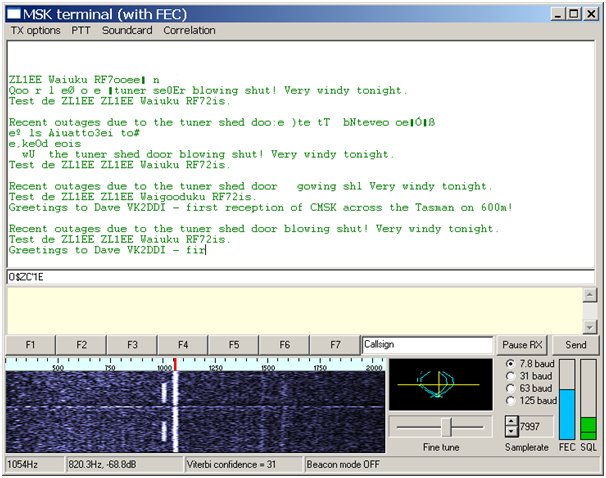 MSK (Minimum Shift Keying) is very similar to PSK, but instead of changing the phase to signal the data bits, the frequency is advanced or retarded a very small amount (exactly half the symbol rate), sufficient to exactly achieve a 180 degree phase shift in one bit period. Because the resulting phase change is produced smoothly, without any sudden changes in phase, the signal does not require raised cosine (amplitude) modulation or other means of spectrum management. For PSK modes, such modulation must be employed to drop the output to zero at the phase change, in order to reduce the keying sidebands. The MSK spectrum is very similar to PSK, but the phase relationship between the carrier and the data is different. MSK is little used on HF, but has been widely used on LF, notably (at 100 baud and 200 baud) for DGPS beacons, and (at 50 baud and 100 baud) for VLF submarine communications.
MSK (Minimum Shift Keying) is very similar to PSK, but instead of changing the phase to signal the data bits, the frequency is advanced or retarded a very small amount (exactly half the symbol rate), sufficient to exactly achieve a 180 degree phase shift in one bit period. Because the resulting phase change is produced smoothly, without any sudden changes in phase, the signal does not require raised cosine (amplitude) modulation or other means of spectrum management. For PSK modes, such modulation must be employed to drop the output to zero at the phase change, in order to reduce the keying sidebands. The MSK spectrum is very similar to PSK, but the phase relationship between the carrier and the data is different. MSK is little used on HF, but has been widely used on LF, notably (at 100 baud and 200 baud) for DGPS beacons, and (at 50 baud and 100 baud) for VLF submarine communications.
The HUGE advantage of MSK over PSK is that because there is no amplitude information on the signal, the transmitting amplifier need not be linear. The transmitter duty cycle is always 100%, not reduced by the AM modulation, so the average signal strength is greater. In other respects the mode is similar to PSK, and in fact the same receiver demodulator can be used, although a different means of recovering symbol sync is required.
[ updated 2024-08-28 ]
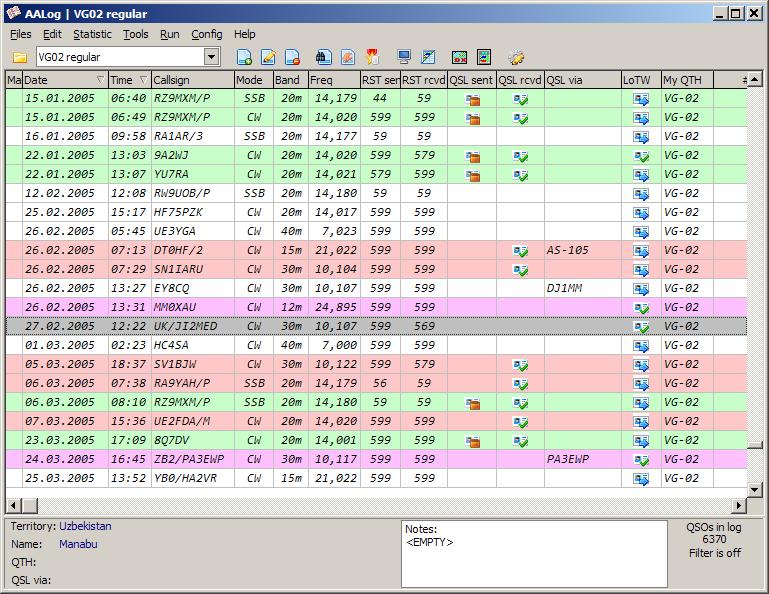 A comprehensive logger program designed for amateur radio station operators. It has a convenient interface, a good set of tools, and is fast and very easy to use. It looks like your paper logbook and uses all power of your computer. It can be integrated with the CW terminal program CwType, morse decoder CwGet and RTTY/PSK31 software TrueTTY. Also you can use AAVoice for voice operations. AALog is LoTW and eQSL.cc compatible.
A comprehensive logger program designed for amateur radio station operators. It has a convenient interface, a good set of tools, and is fast and very easy to use. It looks like your paper logbook and uses all power of your computer. It can be integrated with the CW terminal program CwType, morse decoder CwGet and RTTY/PSK31 software TrueTTY. Also you can use AAVoice for voice operations. AALog is LoTW and eQSL.cc compatible.
[ updated 2024-08-28 ]
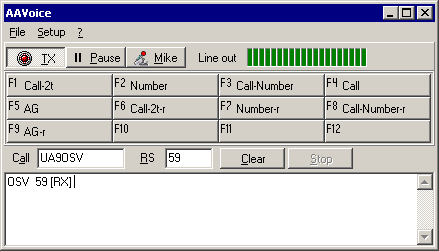 A digital voice processor for amateur radio operators. It uses prepared wav-files for transmission. If necessary you can use simple circuit for PTT-control. It has a lot macros for transmitting. It can interface with AALog logger and can be used via "COM-interface" to work with other compatible programs.
A digital voice processor for amateur radio operators. It uses prepared wav-files for transmission. If necessary you can use simple circuit for PTT-control. It has a lot macros for transmitting. It can interface with AALog logger and can be used via "COM-interface" to work with other compatible programs.
[ updated 2024-08-28 ]
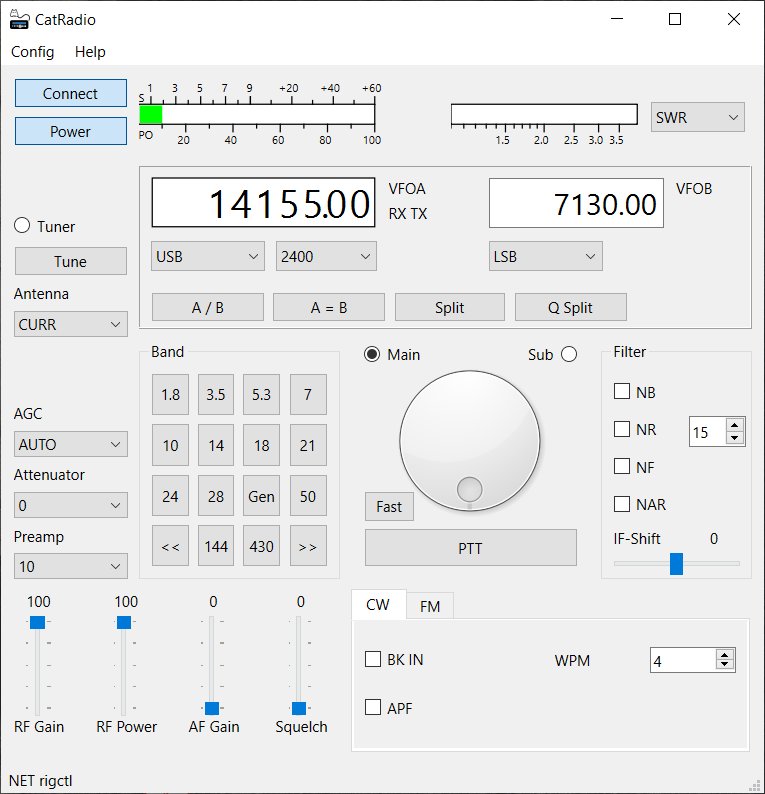 CatRadio is a PC control software for receivers and radio transmitters with a simple and intuitive graphic interface. The main commands used on a radio are collected in a single window, without the need to find them on the device itself, often hidden in complicated menus with less than ergonomic buttons and displays. It also allows full control of the radio, without taking your eyes off the PC, now a fundamental accessory and focal point in an amateur radio station.
CatRadio is a PC control software for receivers and radio transmitters with a simple and intuitive graphic interface. The main commands used on a radio are collected in a single window, without the need to find them on the device itself, often hidden in complicated menus with less than ergonomic buttons and displays. It also allows full control of the radio, without taking your eyes off the PC, now a fundamental accessory and focal point in an amateur radio station.
[ updated 2024-08-28 ]
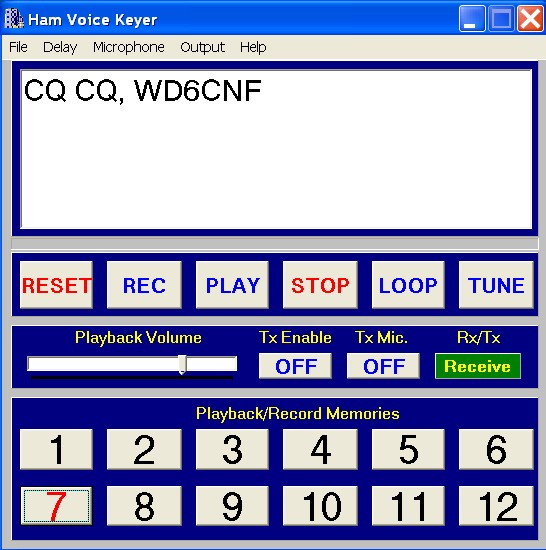
[ updated 2024-08-28 ]
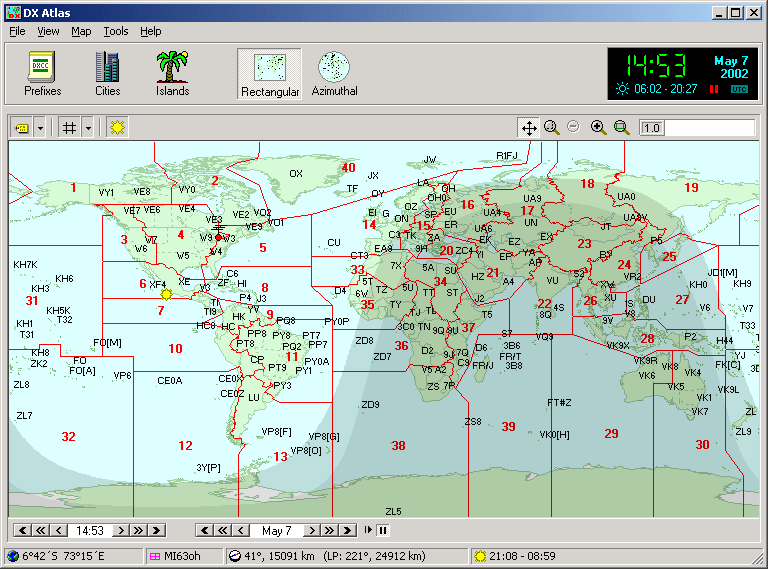 Electronic World atlas for Radio Amateurs. Scrollable World map with smooth zoom, DXCC territories, province/state prefixes, Grid Squares, CQ and ITU Zones in the rectangular, azimuthal and Globe projections, 3D relief, Gray Line, city and island index, unique hierarchical prefix database, local time with DST for all cities, islands and call areas, unique ionospheric maps. Integrates with HamCAP, IonoProbe, Band Master, and many 3-rd party programs.
Electronic World atlas for Radio Amateurs. Scrollable World map with smooth zoom, DXCC territories, province/state prefixes, Grid Squares, CQ and ITU Zones in the rectangular, azimuthal and Globe projections, 3D relief, Gray Line, city and island index, unique hierarchical prefix database, local time with DST for all cities, islands and call areas, unique ionospheric maps. Integrates with HamCAP, IonoProbe, Band Master, and many 3-rd party programs.
[ updated 2024-08-28 ]
Welcome to the DX4WIN home page. DX4WIN is an easy to use, yet powerful logging program for every ham. It has been designed for the serious and the casual DXer. It has a number of features that make operating in a contest fun from the DXers perspective, and if you use a contesting program, DX4WIN can import your log after the contest.
DXLab is a freeware suite of eight interoperating applications that can be installed independently in any order. When multiple applications are running, they sense each other's presence and automatically interoperate to support your Amateur Radio DXing activities.
The program allows worldwide connections to be made between stations, or from computer to station, greatly enhancing Amateur Radio's communications capabilities. There are more than 200,000 validated users worldwide - in 151 of the world's 193 nations - with about 6,000 online at any given time.
EchoStation is perfect for portable and emergency use, or for clubs wishing to use a PC instead of specialized hardware to control a repeater. It also makes an excellent "store and forward" simplex repeater when connected to a single transceiver. The software even lets you set up an "announcement machine" which plays scheduled voice announcements over your club's existing repeater, using a radio at another location, such as a home station.
flrig is a rig control program, software cooperates with fldigi.
The forerunner to Ham Radio Deluxe by Simon Brown.
Ham Radio Deluxe (HRD) is a suite of Windows programs providing CAT control for commonly used transceivers and receivers. HRD also includes mapping and PSK31 software.
Hamport is a small program for RIG control. It can read and set mode and frequency on your transceiver. This is beta version. The program can only control ICOM, Yaesu and Kenwood transceivers at present. On Windows 8 and higher run as administrator.
KComm is meant to be an easy to use low resource usage log keeping program for the average K2 or K3 operator who may be a casual DXer or contest participant. Rather than try to do everything itself, KComm interfaces with some of the best available software for data mode operation and morse decoding so that you can use one logging program for all modes.
Welcome to Logger32, a 32-bit Amateur Radio logging program written by Bob Furzer, K4CY. Bob is also the author of Zakanaka, and a 16-bit version of Logger. Logger32 has been developed to be a highly user configurable general purpose Amateur Radio logbook with computer control support for many radios and antenna rotators. It is NOT a contesting log, although there is no real reason why it could not be used for such, and does not contain some features that might be found in software specifically designed for this activity.
N1MM Logger is the world's most popular contest logging program. For CW, phone and digital modes, its combination of contest-optimized features is unmatched. The program can be used with Windows XPsp3/Vista/7/8/10/11.
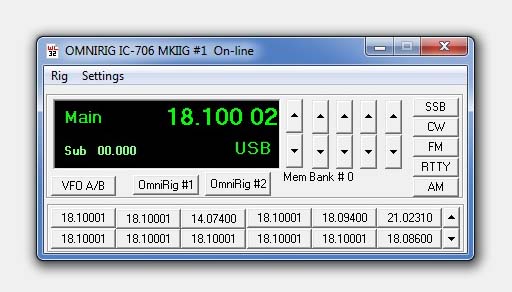
[ updated 2024-09-05 ]
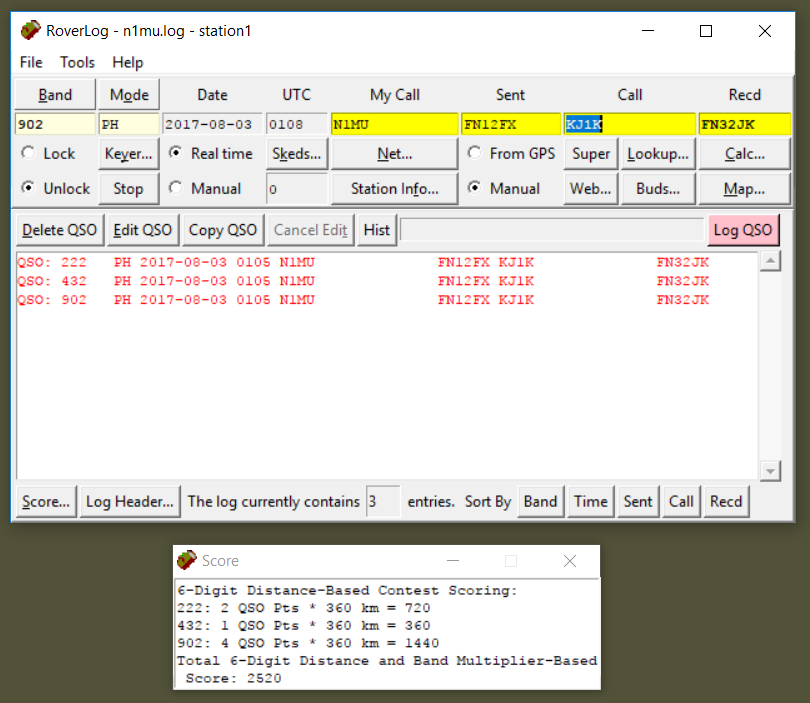 RoverLog is a contest logging program for VHF, UHF, and microwave contests that use Maidenhead grid squares as their exchange. The original specification for this program was written by Sigurd Kimpel, KJ1K. The actual program was written by Tom Mayo, N1MU. The program is distributed under the Gnu Public License, which basically means the source code must always be kept free.
RoverLog is a contest logging program for VHF, UHF, and microwave contests that use Maidenhead grid squares as their exchange. The original specification for this program was written by Sigurd Kimpel, KJ1K. The actual program was written by Tom Mayo, N1MU. The program is distributed under the Gnu Public License, which basically means the source code must always be kept free.
Last Web Site updated 2017. Software uses an odd complier, written in a language called Tcl/Tk.
[ updated 2024-09-05 ]
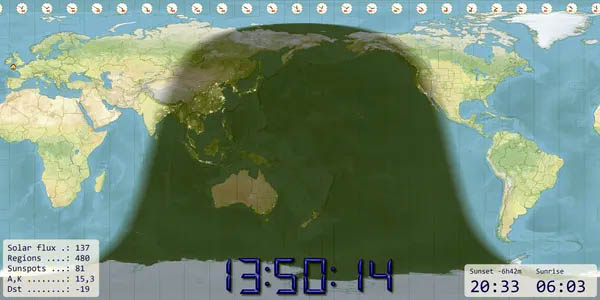 World mapping software from Simon Brown. This is a rewrite of a previous project from many years ago. It requires minimal CPU power, will run on any Windows 7 / 8 / 10 / 11 system using x86 architecture. Written to learn new areas of Direct2D graphics and new features of Visual Studio 2022. As time permits the program will be updated; there are interesting ideas in the pipeline.
World mapping software from Simon Brown. This is a rewrite of a previous project from many years ago. It requires minimal CPU power, will run on any Windows 7 / 8 / 10 / 11 system using x86 architecture. Written to learn new areas of Direct2D graphics and new features of Visual Studio 2022. As time permits the program will be updated; there are interesting ideas in the pipeline.
[ updated 2024-08-28 ]
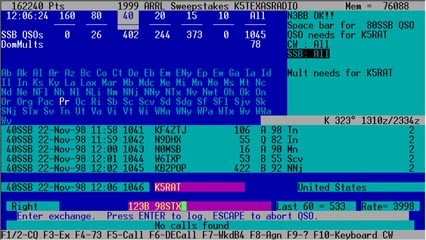 TR LOG is a high-performance Amateur Radio contest logging program designed to make the most of your computer during a contest. It is designed so that the process of making and logging contacts is as efficient as possible - so you make more contacts.
TR LOG is a high-performance Amateur Radio contest logging program designed to make the most of your computer during a contest. It is designed so that the process of making and logging contacts is as efficient as possible - so you make more contacts.
This software is very old. Only trial versions can be downloaded. Web site not updated since 2006.
[ updated 2024-09-05 ]
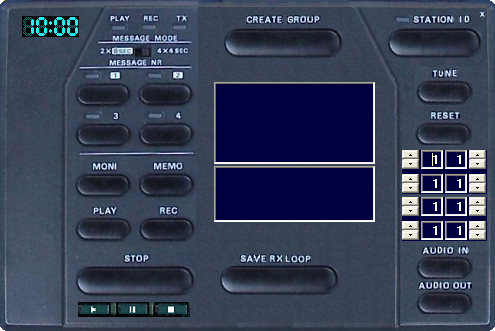 The UDY-2 Voice Keyer digital voice keyer amateur radio software utility integrates many popular voice keyer features in one convenient easy to use program. Whether you're working a contest as multi op, single op, running a net, or just plain rag chewing the UDY-2 Voice Keyer has something to make hamming more fun and convenient for you.
The UDY-2 Voice Keyer digital voice keyer amateur radio software utility integrates many popular voice keyer features in one convenient easy to use program. Whether you're working a contest as multi op, single op, running a net, or just plain rag chewing the UDY-2 Voice Keyer has something to make hamming more fun and convenient for you.
This software and web site is not managed anymore. Original Web Site found on the Wayback Machine: http://www.kd4udy.com/UDY-2VoiceKeyer/
Can't find if KD4UDY still active. License has expired.
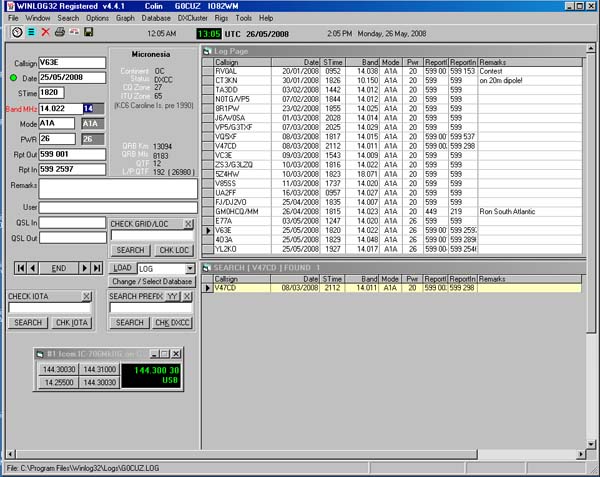 Winlog32 is Amateur Radio Logging Software.
Winlog32 is Amateur Radio Logging Software.
[ updated 2024-08-28 ]
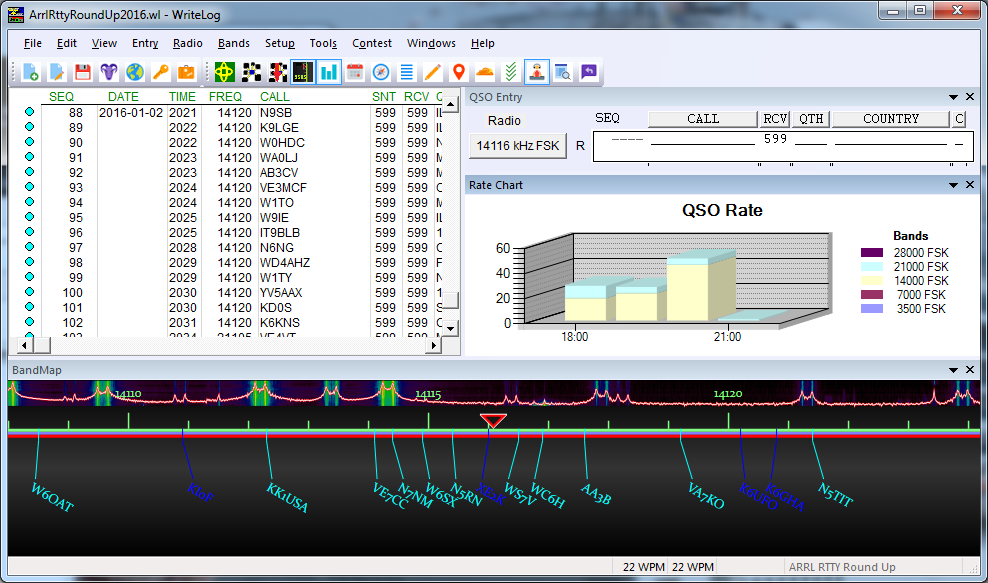 Contest logging software for winning CW, SSB, RTTY and PSK31.
Contest logging software for winning CW, SSB, RTTY and PSK31.
[ updated 2024-08-28 ]
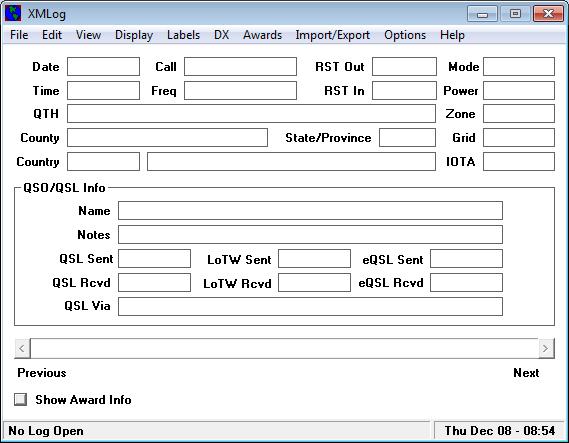 XMLog is an amateur radio logbook system. There is no charge for using XMLog. Permission to distribute XMLog for profit is prohibited.
XMLog is an amateur radio logbook system. There is no charge for using XMLog. Permission to distribute XMLog for profit is prohibited.
[ updated 2024-08-28 ]
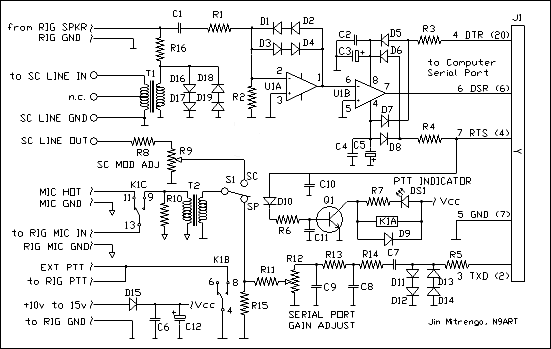 This page is an attempt to systematize the interface diagrams for various Transceivers and Sound Cards. On December 26, 1998, the first version of PSK31, a program for a sound card, was presented to the amateur radio community. Since then, as a result of numerous experiments, a typical connection diagram has begun to emerge. It seems to me that understanding this scheme will save you a lot of time and nerves. Keep in mind that on each circuit diagram, some connections are labeled with letters that correspond to the different pins on the transceiver connectors. Which one can be found in the corresponding tables, for which you just need to click on the button with the name of the corresponding equipment manufacturer, find your transceiver in the table that appears and determine the connection points.
This page is an attempt to systematize the interface diagrams for various Transceivers and Sound Cards. On December 26, 1998, the first version of PSK31, a program for a sound card, was presented to the amateur radio community. Since then, as a result of numerous experiments, a typical connection diagram has begun to emerge. It seems to me that understanding this scheme will save you a lot of time and nerves. Keep in mind that on each circuit diagram, some connections are labeled with letters that correspond to the different pins on the transceiver connectors. Which one can be found in the corresponding tables, for which you just need to click on the button with the name of the corresponding equipment manufacturer, find your transceiver in the table that appears and determine the connection points.
[ updated 2024-08-27 ]